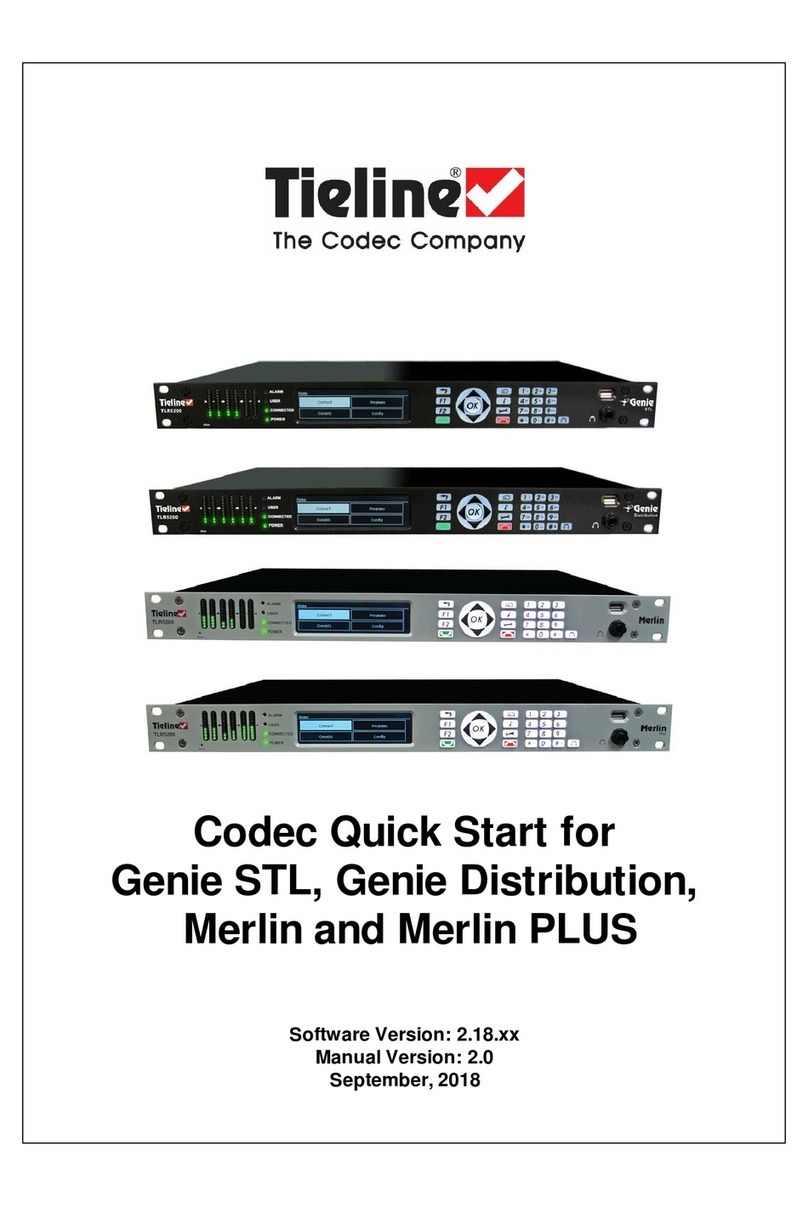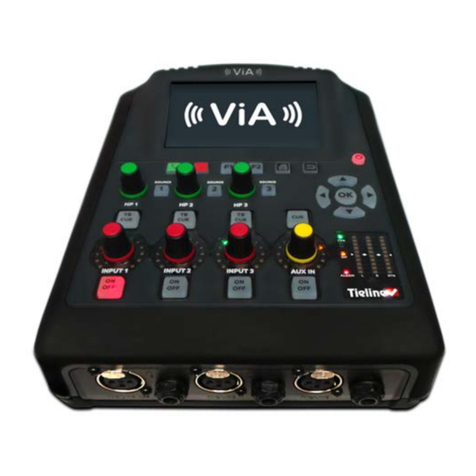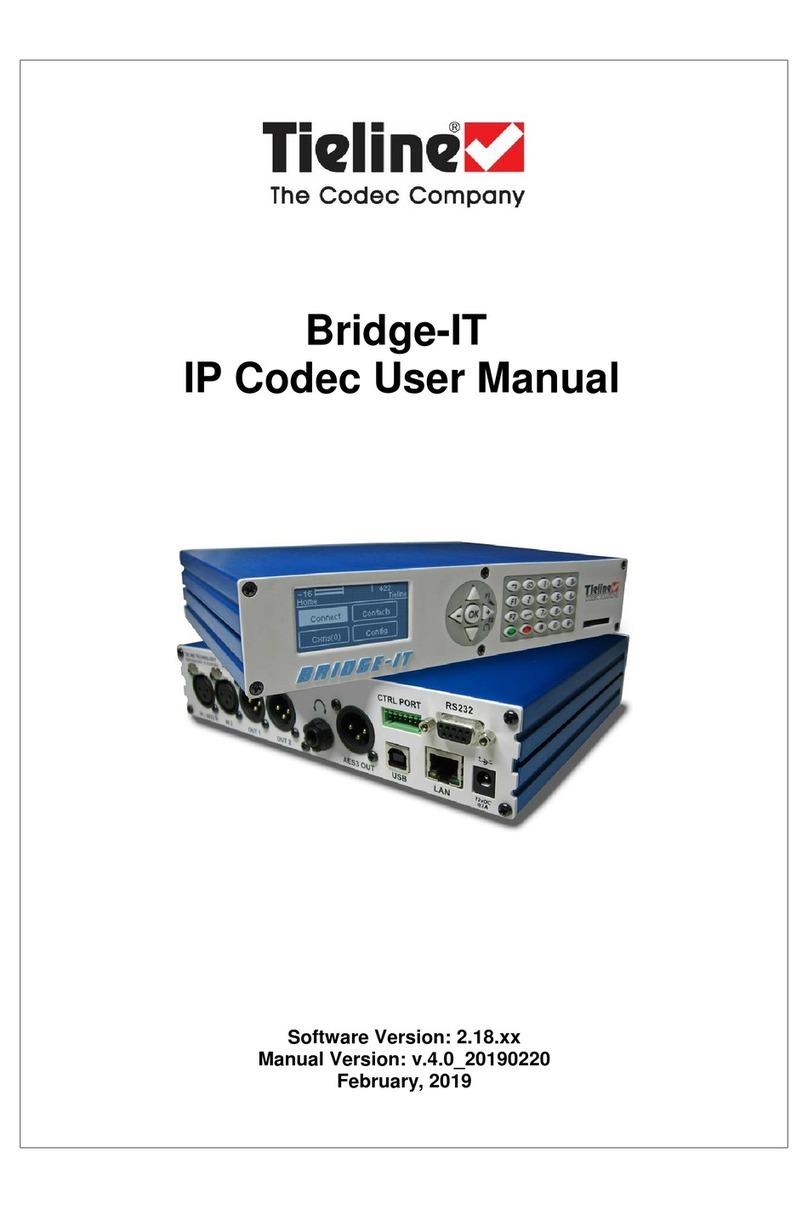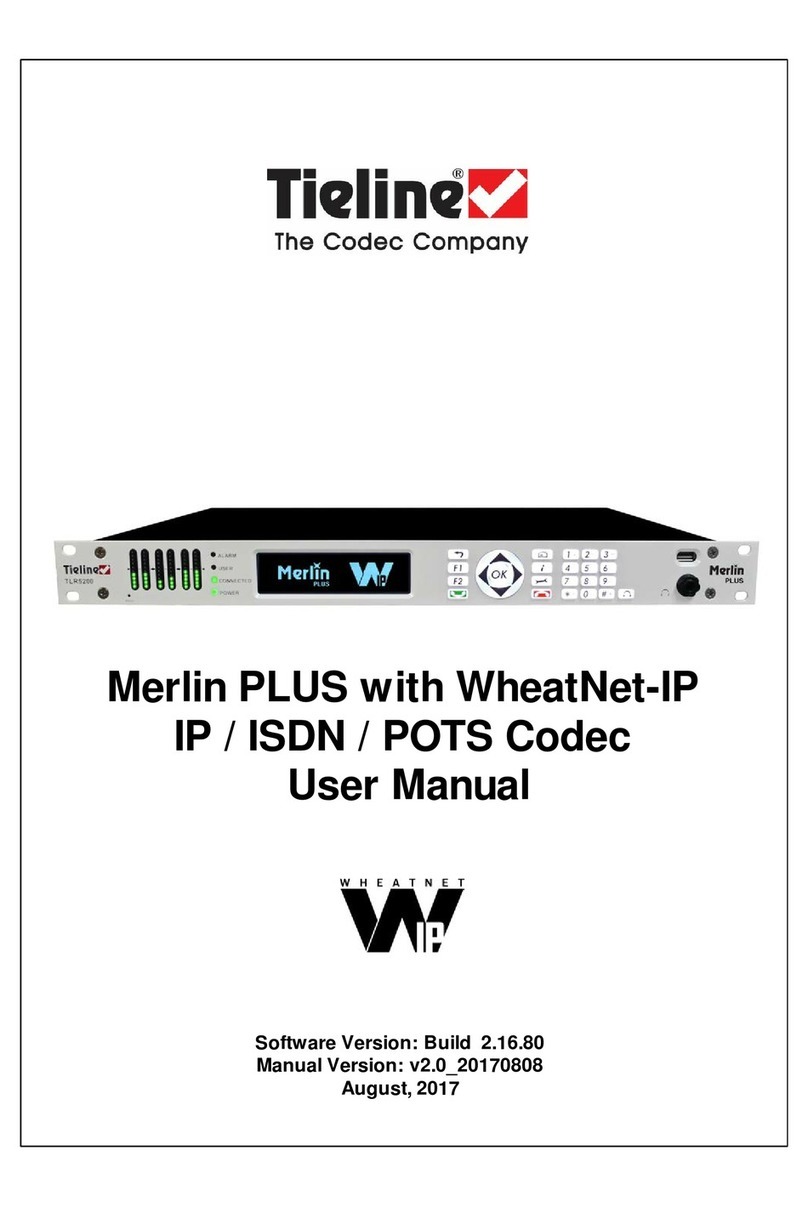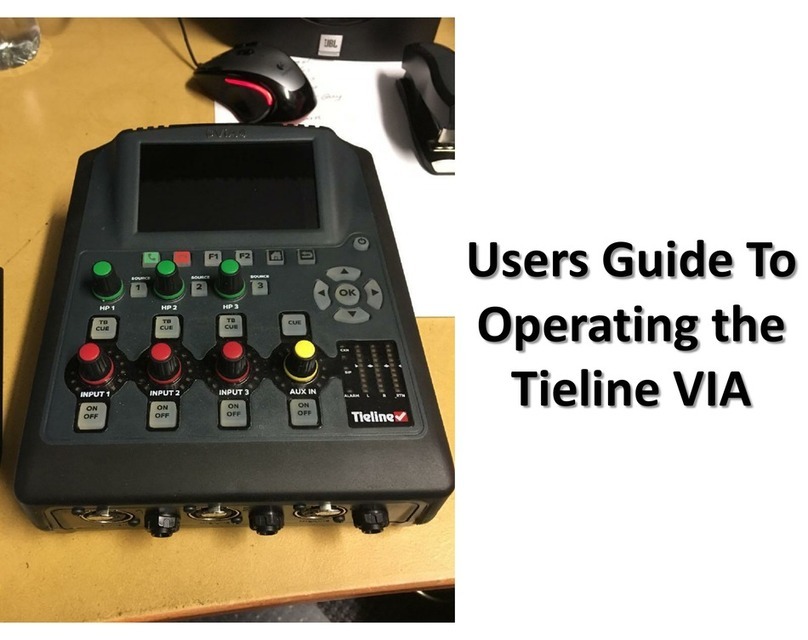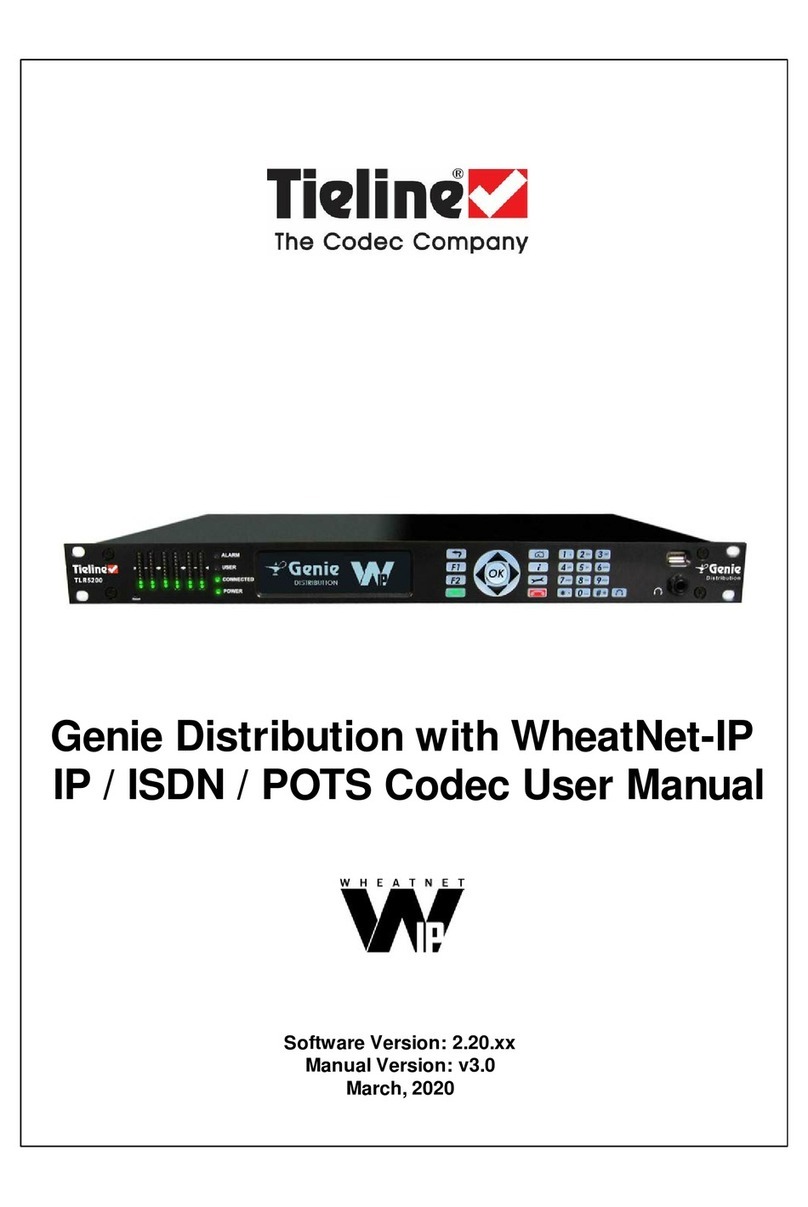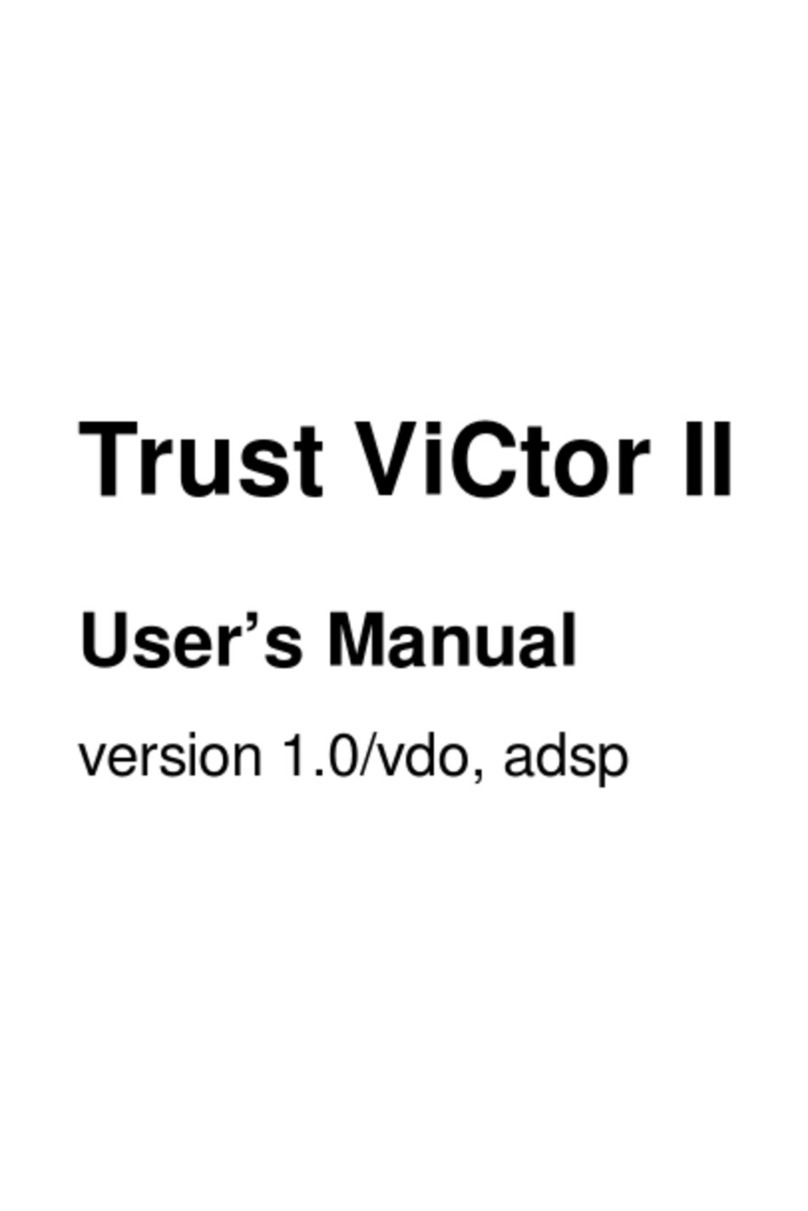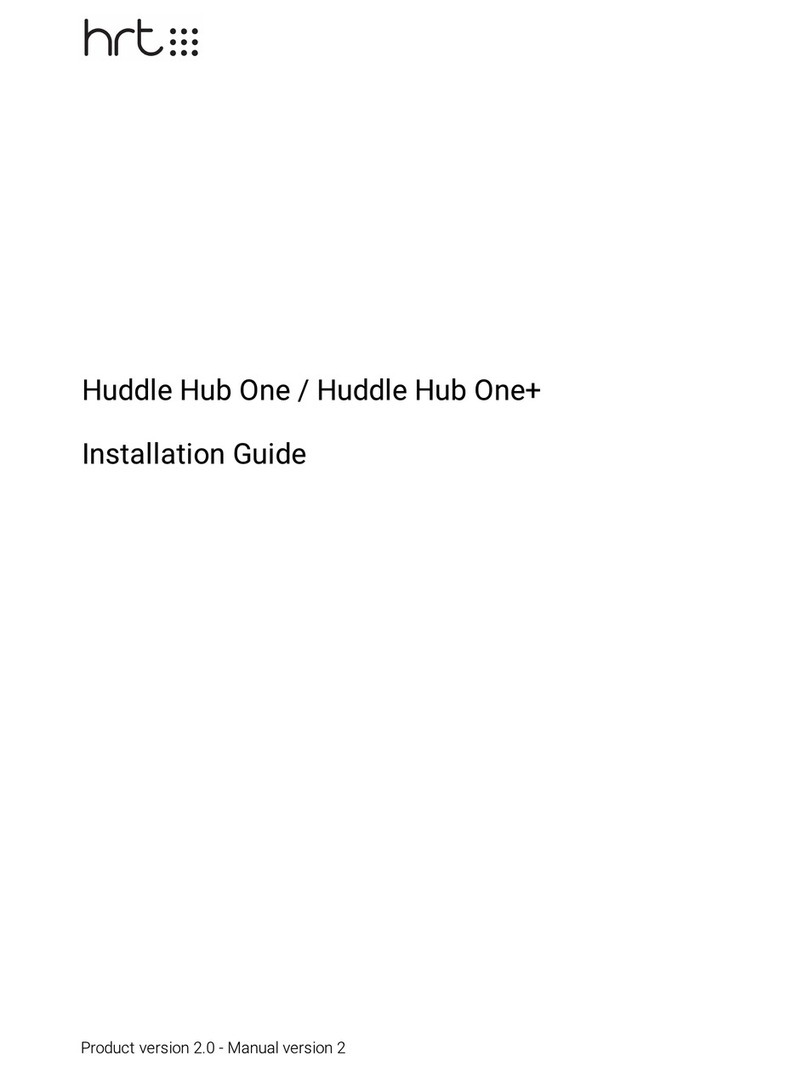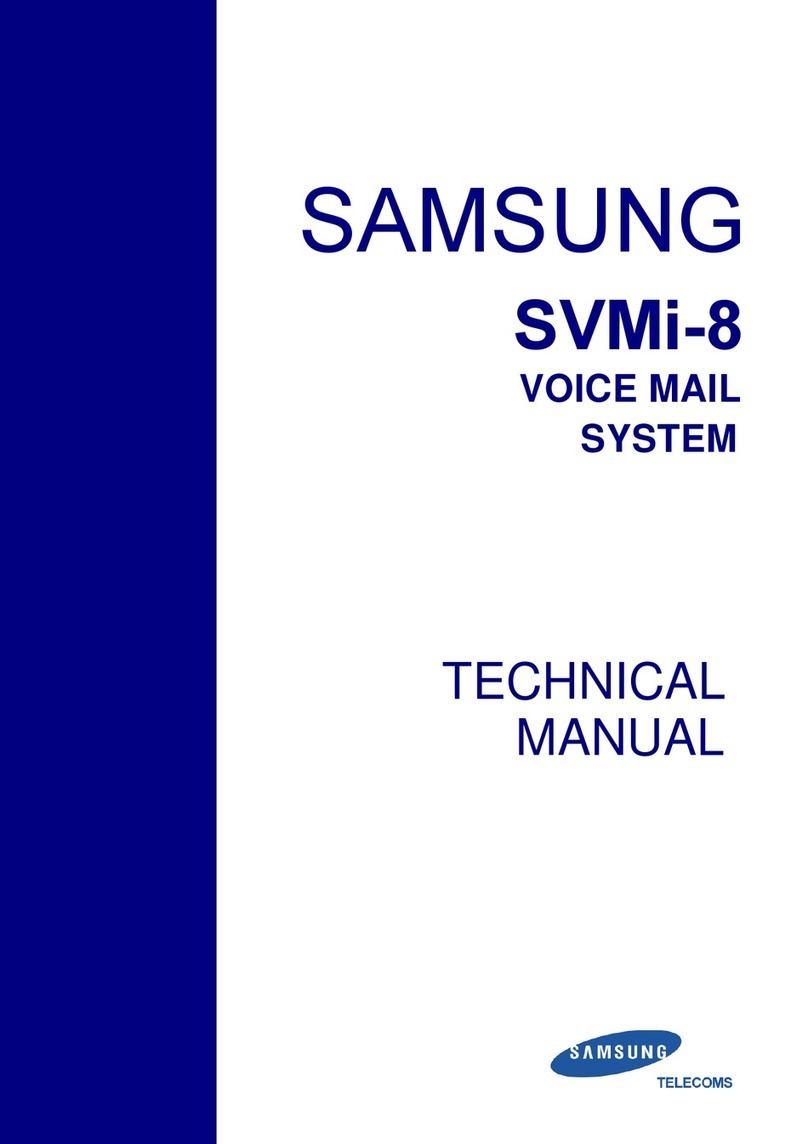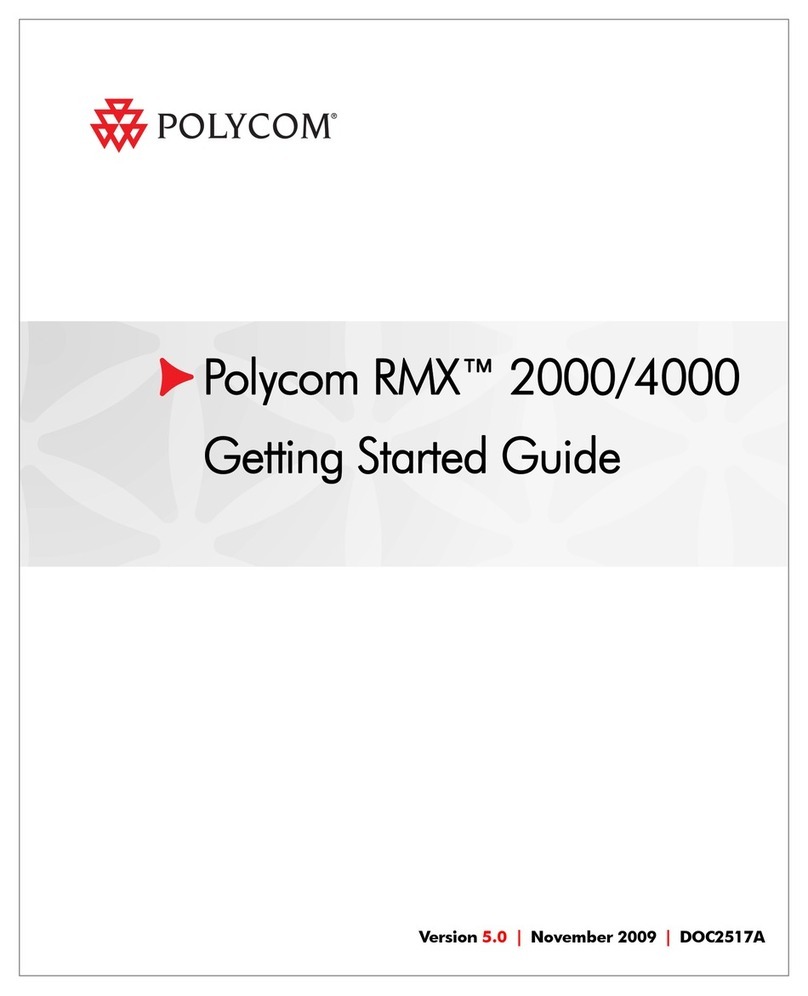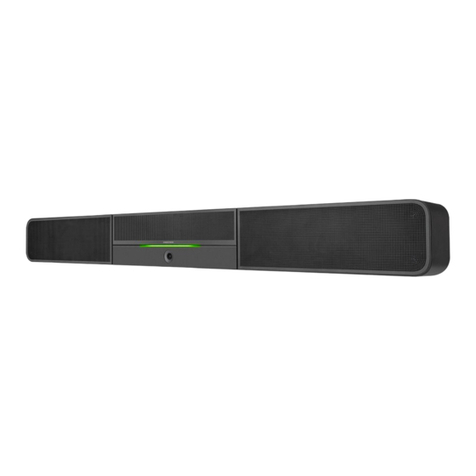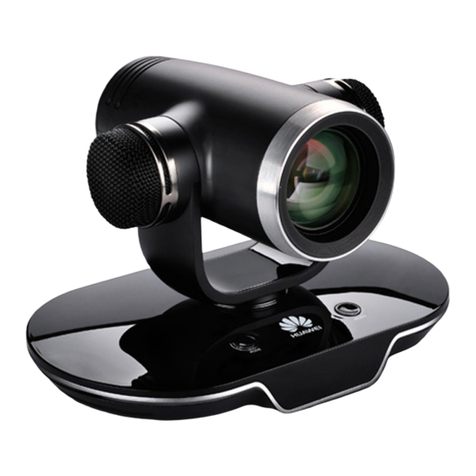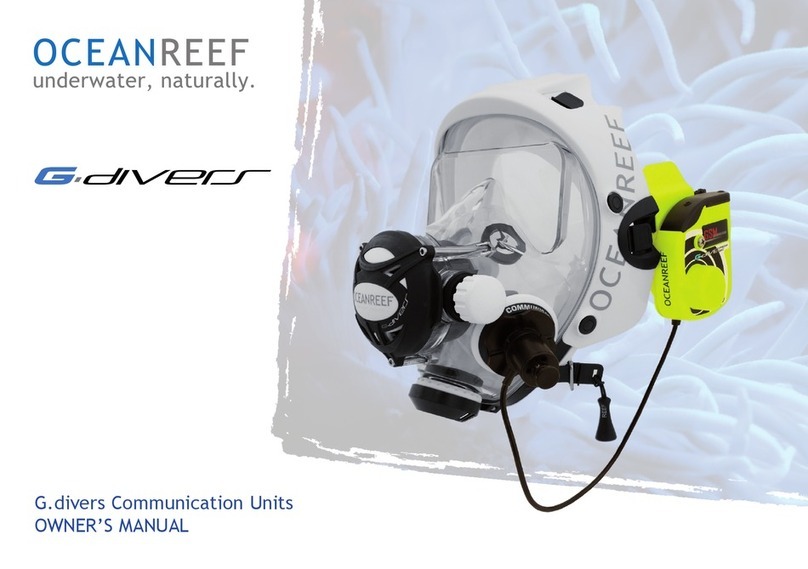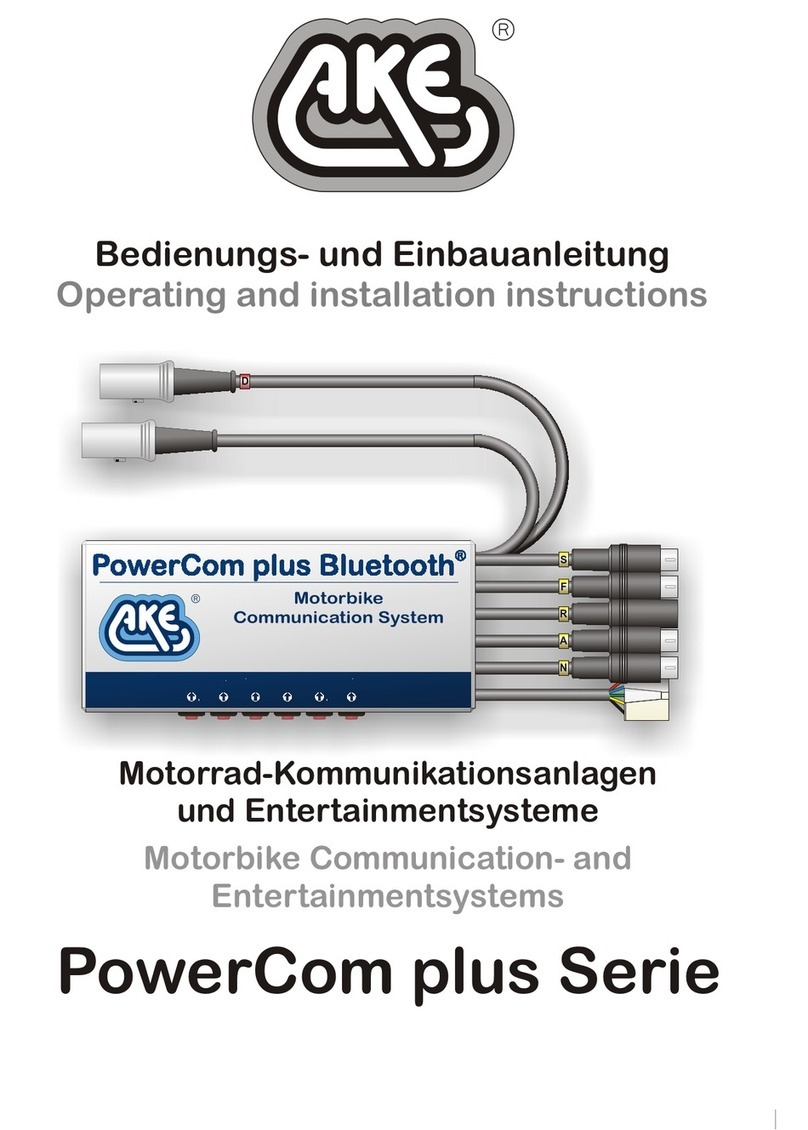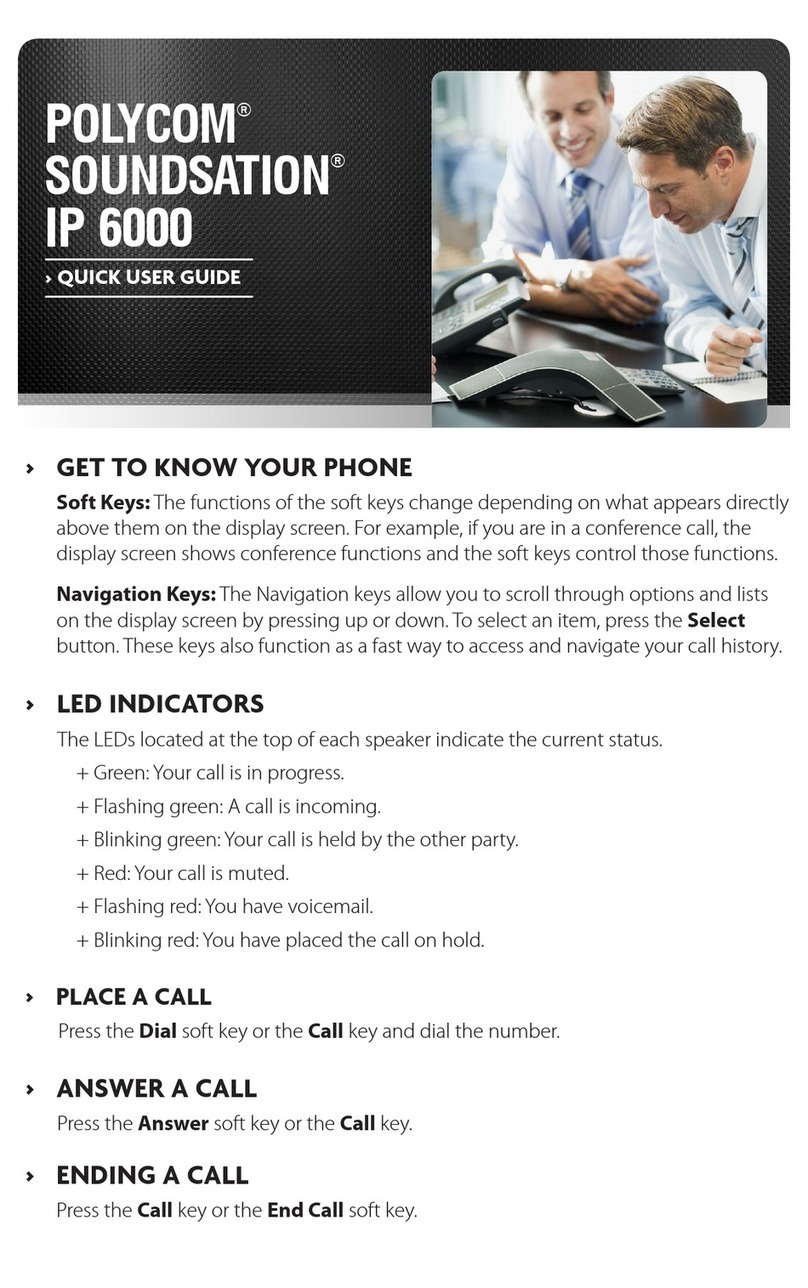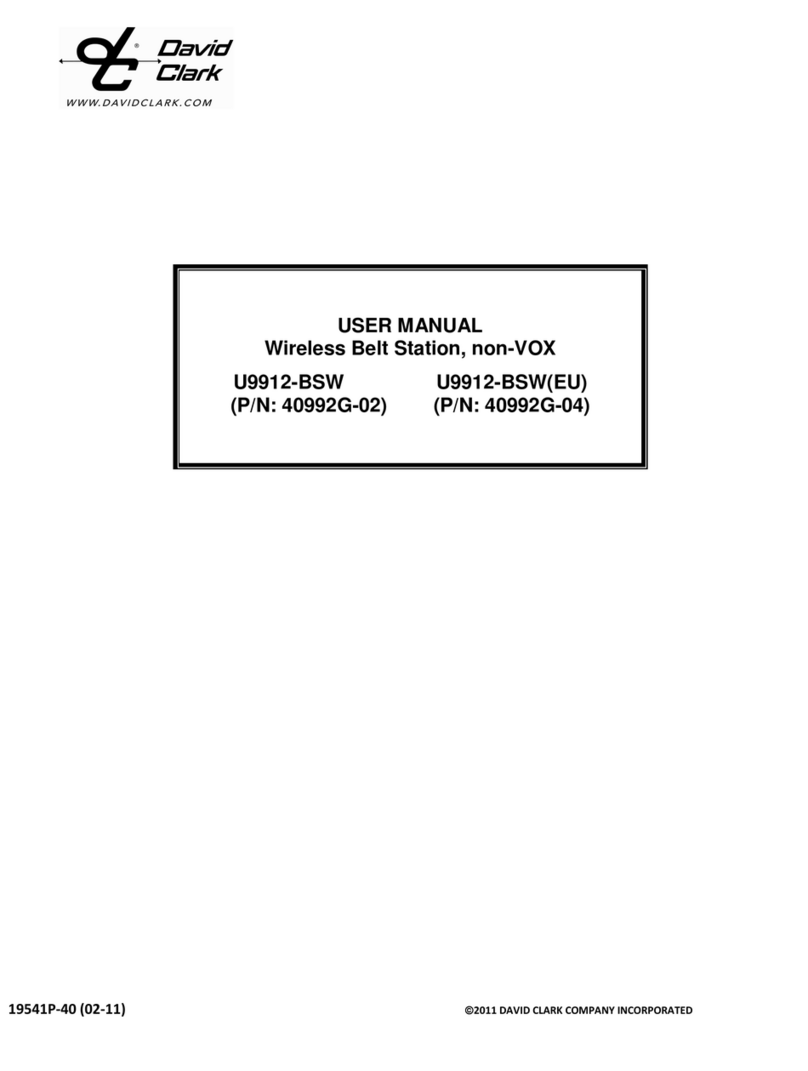Tieline Merlin PLUS User manual

Merlin PLUS
IP / ISDN / POTS Codec
User Manual
Software Version: Build 2.16.80
Manual Version: v2.0_20170808
August, 2017

Merlin PLUS User Manual v2.02
© Tieline Pty. Ltd. 2017
Table of Contents
Part I Warnings & Safety Information 6
Part II How to Use the Documentation 8
Part III Glossary of Terms 9
Part IV Getting to know Merlin PLUS 11
Part V Merlin PLUS Rear Panel
Connections 13
Part VI Merlin Front Panel Controls 15
Part VII Navigating Menus 17
Part VIII Merlin PLUS Input Levels and
PPMs 24
Part IX Configuring AES3 Input Audio 33
Part X Merlin PLUS Headphone/Aux
Output 35
Part XI Inserting Hardware Modules 37
Part XII About ISDN Modules 38
................................................................................................................................... 391ISDN Module Settings
................................................................................................................................... 422ISDN Answering Configuration
Part XIII About POTS Modules 45
................................................................................................................................... 461POTS Module Settings
................................................................................................................................... 492POTS Answering Configuration
Part XIV About SIP 52
................................................................................................................................... 541Configuring SIP Interfaces
................................................................................................................................... 562Configuring SIP Accounts
Part XV Language Selection 58
Part XVI About Program Dialing 59
Part XVII Multiple Stream Programs 61
Part XVIII 6 x Mono Programs 61

3Contents
© Tieline Pty. Ltd. 2017
Part XIX Mono or Stereo + IFB Programs 62
Part XX 2 x Mono or Stereo + IFB
Programs 62
Part XXI Getting Connected Quickly 63
................................................................................................................................... 631Steps to Connect over IP
................................................................................................................................... 662Monitoring IP Connections
................................................................................................................................... 683Steps to Connect over ISDN
................................................................................................................................... 714Monitoring ISDN Connections
................................................................................................................................... 715Steps to Connect over POTS
................................................................................................................................... 746Monitoring POTS Connections
................................................................................................................................... 757Load and Dial Custom Programs
................................................................................................................................... 758Disconnecting a Connection
................................................................................................................................... 759Redialing a Connection
................................................................................................................................... 7510 Configuring Auto Reconnect
................................................................................................................................... 7611 Speed Dialing Connections
................................................................................................................................... 7712 Dial/Disconnect Multiple Audio Stream Programs
................................................................................................................................... 7813 Dialing SIP Connections
................................................................................................................................... 8014 Creating a Multicast Client Program
................................................................................................................................... 8315 Deleting Programs
................................................................................................................................... 8316 Selecting Algorithm Profiles
................................................................................................................................... 8517 Merlin Algorithm Profiles
................................................................................................................................... 8618 Merlin Backup Options
................................................................................................................................... 8819 Lock or Unlock a Program in the Codec
................................................................................................................................... 8920 Locking the Front Panel
Part XXII Connecting to the ToolBox
Web-GUI 90
................................................................................................................................... 901Opening the HTML5 Web-GUI & Login
................................................................................................................................... 932Security and Changing the Default Password
Part XXIII Using the HTML5 Toolbox
Web-GUI 95
................................................................................................................................... 1101Using the HTML5 Toolbox Quick Connect Web-GUI
................................................................................................................................... 1162Configuring IP Settings
................................................................................................................................... 1213Configure Fuse-IP Bonding
................................................................................................................................... 1244Line Hunt Call Answering
................................................................................................................................... 1265Configuring ISDN
................................................................................................................................... 1346Configuring POTS
................................................................................................................................... 1397Configuring Input/Output Settings
................................................................................................................................... 1438Configure Mono or Stereo Peer-to-Peer Programs in Merlin
................................................................................................................................... 1549Configure 2 Mono Peer-to-Peer Answering Programs in Merlin

Merlin PLUS User Manual v2.04
© Tieline Pty. Ltd. 2017
................................................................................................................................... 15910 Configure Mono or Stereo + IFB Dialing Programs
................................................................................................................................... 17111 Configure Mono or Stereo + IFB Answering Programs
................................................................................................................................... 17712 Configure 2 Mono or Stereo + IFB Answering Programs
................................................................................................................................... 18413 Configure 6 x Mono Peer-to-Peer Answering Programs
................................................................................................................................... 19114 Configure 6 x Mono Peer-to-Peer Answering Programs
................................................................................................................................... 19815 Configure Multicast Client Programs
................................................................................................................................... 20316 Configuring SIP
................................................................................................................................... 21017 Configure Peer-to-Peer SIP Programs
................................................................................................................................... 21418 Configure Multiple Stream SIP Programs
................................................................................................................................... 21919 Answering Multiple SIP Peer-to-Peer Calls
................................................................................................................................... 22120 Load, Unload and Dial a Program
................................................................................................................................... 22421 Delete a Program
................................................................................................................................... 22522 Adjusting the Connection Bit Rate
................................................................................................................................... 22523 Reset Factory Default Settings
................................................................................................................................... 22624 Backup and Restore Functions
................................................................................................................................... 22825 Lock or Unlock Programs
................................................................................................................................... 22926 Configuring SNMP in the Codec
................................................................................................................................... 23027 Download Logs
................................................................................................................................... 23228 Using the Program Scheduler
................................................................................................................................... 23629 Configuring Alarms
................................................................................................................................... 24230 RS232 Data Configuration
................................................................................................................................... 24431 Creating Rules
................................................................................................................................... 24932 Adjusting Codec Time and Date
................................................................................................................................... 25033 Upgrading Codec Firmware
Part XXIV Front Panel Configuration Tasks 252
................................................................................................................................... 2521Configuring IP via the Front Panel
................................................................................................................................... 2552IP Via Mapping
................................................................................................................................... 2573Connecting over Wi-Fi
................................................................................................................................... 2594Inverting Input Polarity
................................................................................................................................... 2605Connecting with Fuse-IP Bonding
................................................................................................................................... 2656Selecting an Algorithm
................................................................................................................................... 2727Configuring the Jitter Buffer
................................................................................................................................... 2768Configuring Forward Error Correction
................................................................................................................................... 2799Configuring Encode/Decode Direction
................................................................................................................................... 28010 Enabling Relays & RS232 Data
................................................................................................................................... 28111 Configuring TCP/UDP Ports
................................................................................................................................... 28312 Configuring QoS for IP Packets
................................................................................................................................... 28413 Tieline G3 Profile Compatibility
................................................................................................................................... 28514 Reset and Restore Factory Default Settings
................................................................................................................................... 28715 System Backup and Restore
................................................................................................................................... 28916 Configuring SNMP Settings

5Contents
© Tieline Pty. Ltd. 2017
................................................................................................................................... 29017 Adjusting the LCD Screen Display
................................................................................................................................... 29118 Adjusting Time Settings
................................................................................................................................... 29119 Test Mode
................................................................................................................................... 29220 Upgrading Firmware via USB
................................................................................................................................... 29321 Installing a Security Certificate
Part XXV Reference 296
................................................................................................................................... 2961Regular Maintenance
................................................................................................................................... 2972Installing the Codec at the Studio
................................................................................................................................... 3033Understanding IP Networks
................................................................................................................................... 3054Tips for Creating Reliable IP Connections
................................................................................................................................... 3065Testing IP Network Connections
................................................................................................................................... 3086Testing ISDN Connections
................................................................................................................................... 3087Using Answer Routes for Sessionless ISDN Calls
................................................................................................................................... 3118POTS Connection Tips & Precautions
................................................................................................................................... 3139Merlin Compliances and Certifications
................................................................................................................................... 31310 FCC Compliance Statements
................................................................................................................................... 31511 Declaration of Conformity
................................................................................................................................... 31612 Trademarks and Credit Notices
Part XXVI Merlin PLUS Specifications 317
Part XXVII Appendix A: RS232 and Control
Port Wiring 319
Part XXVIII Appendix B: DB25 Wiring 320
Index 322

6Merlin PLUS User Manual v2.0
© Tieline Pty. Ltd. 2017
1Warnings & Safety Information
1. Both appliance power cables must be removed from the device for Power Disconnection.
2. Remove the phone cable from the POTS interface before servicing.
THUNDERSTORM AND LIGHTNING WARNING:
DO NOT USE Tieline codecs during thunderstorms and lightning. You may suffer an injury
using a phone, Tieline codec, or any device connected to a phone during a thunderstorm.
This can lead to personal injury and in extreme cases may be fatal. Protective devices can
be fitted to the line, however, due to the extremely high voltages and energy levels involved
in lightning strikes, these devices may not offer protection to the users, or the Tieline codec
and equipment connected to the codec.
Secondary strikes can occur. These secondary strikes are induced by lightning strikes and
also produce dangerously high currents and energy levels. You only need to be near an
object struck by lightning to lead to personal injury or damage to equipment. e.g. if you are
located near a lighting tower at a sports facility, water features and drains on golf courses,
you may be affected by these secondary strikes.
Damage to personnel and Tieline codecs may occur during thunderstorm, even if the codec
is turned off but remains connected to the phone or ISDN system, LANor the power.
ANY DAMAGE TO A TIELINE PRODUCT CAUSED BY LIGHTNING or an ELECTRICAL
STORM WILL VOID THE WARRANTY. Use of this product is subject to Tieline's
SOFTWARE LICENSE and WARRANTY conditions, which should be viewed at
www.tieline.com/support before using this product.
DIGITAL PHONE SYSTEM WARNING:
DO NOT CONNECT THE ANALOG POTS MODULE TO A DIGITAL PHONE SYSTEM.
PERMANENT DAMAGE MAY OCCUR! If you are unfamiliar with any facility, check that the
line you are using is NOT a digital line. If the Tieline codec becomes faulty due to the use
of a digital phone system, the WARRANTY WILL BE VOID.
WARNING:
HIGH LEAKAGE CURRENT. EARTH CONNECTION ESSENTIAL BEFORE CONNECTING
SUPPLY.
If the total leakage current exceeds 3.5 mA, or if the leakage current of the connected
loads is unknown, connect the supplementary ground terminal to a reliable ground
connection in your facility.
Supplementary ground connection
A supplementary ground terminal is provided on the codec to connect the unit to a ground
connection. The ground terminal has an M4 stud with M4 retaining nuts and is compatible
with all grounding wires. Remove only NUT 2 to connect your ground wire. The ground wire
must have a suitable lug. When refitting NUT 2 ensure that both NUT 1 & NUT 2 are
correctly tightened to establish and maintain a proper earth connection.

7
© Tieline Pty. Ltd. 2017
Merlin PLUS User Manual v2.0
SAFE LISTENING GUIDANCE
WARNING: LISTENING TO AUDIO AT EXCESSIVE VOLUMES CAN CAUSE
PERMANENT HEARING DAMAGE. USE AS LOW A VOLUME AS POSSIBLE.
Over exposure to excessive sound levels can damage your ears resulting in permanent
noise-induced hearing loss (NIHL). Please use applicable health and safety authority
guidelines on maximum exposure limits. As a rule of thumb, avoid extended periods
listening to sound pressure levels (SPLs) of 85dBA or higher.
Warranty and Disclaimer
This equipment manufactured by Tieline is warranted by Tieline against defects in material and
workmanship for two years from the date of original purchase. During the warranty period, we will
repair or, at our option, replace at no charge a product that proves to be defective, provided you
obtain return authorization from Tieline and return the product, shipping prepaid, to Tieline. For return
authorization, contact Tieline's US or Australian office (see http://www.tieline.com/Contact-Us).
This Warranty does not apply if the product has been damaged by accident or misuse or as the
result of service or modification performed by anyone other than Tieline. With the exception of the
warranties set forth above, Tieline makes no other warranties, expressed or implied or statutory,
including but not limited to warranties of merchantability and fitness for a particular purpose, which
are hereby expressly disclaimed. In no event shall Tieline have any liability for indirect,
consequential or punitive damages resulting from the use of this product. Use of this product is
subject to Tieline's SOFTWARE LICENSE and WARRANTY conditions, which should be viewed at
http://www.tieline.com/Support/Product-Warranty before using this product.
Whilst every effort has been made to ensure the accuracy of this manual we are not responsible for
any errors or omissions within it. The product specifications and descriptions within this manual will
be subject to improvements and modifications over time without notice, as changes to software and
hardware are implemented. Tieline takes no responsibility for any damage to equipment attached to
the codec.

8Merlin PLUS User Manual v2.0
© Tieline Pty. Ltd. 2017
2How to Use the Documentation
Manual Conventions
Warnings: Instructions that, if ignored, could result in death or serious personal injury
caused by dangerous voltages or incorrect operation of the equipment. These must be
observed for safe operation.
Cautions: Instructions warning against potential hazards, or to detail practices that must
be observed for safe operation and to prevent damage to equipment or personnel.
Important Note: Information you should know to connect and operate your codec
successfully.
Information specific to IP connections.
Information specific to ISDN connections.
Information specific to POTS connections.
Typographic Conventions
·
Codec software elements are in Arial bold, e.g. Contacts
·
Codec hardware elements are in bold Capitals, e.g. KEYPAD
Help Button
Press the (information/help) button when navigating codec menus to display a dialog
suggesting the actions which can be performed from within the current menu.

9
© Tieline Pty. Ltd. 2017
Merlin PLUS User Manual v2.0
3Glossary of Terms
AES/EBU
Digital audio standard used to carry digital audio signals between devices
AES3
Official term for the audio standard referred to often as AES/EBU
BRI
Basic Rate Interface for ISDN services
DN
Directory Number for ISDN
DNS
The Domain Name System (DNS) is used to assign domain names to IP
addresses over the World-Wide Web
Domain
A group of computers or devices on a network which are administered with
common rules and procedures. Devices sharing a common part of the IP
address are said to be in the same domain
DSCP
The Differentiated Services Code Point is a field in an IP packet header for
prioritizing data when traversing IP networks
Failover
Method of switching to an alternative backup audio stream if the primary
connection is lost.
GUI
Graphical User Interface
IFB
Interrupted Foldback/Interruptible Foldback: an intercom circuit consisting of a
mix-minus program feed sent to talent, which can be interrupted and replaced
by a producer's or director's intercom microphone
ISDN
Integrated Services Digital Network
ISP
Internet Service Providers (ISPs) are companies that offer customers access to
the internet
IP
Internet Protocol; used for sending data across packet-switched networks
LAN
Local Area Network; a group of computers and associated devices sharing a
common communications link
Latency
Delay associated with IP networks and caused by algorithmic, transport and
buffering delays
MIB
A management information base (MIB) is a database used for managing the
entities in a communications network. This term is associated with the Simple
Network Management Protocol (SNMP).
Multicast
Efficient one to many streaming of IP audio using multicast IP addressing
Multi-unicast
A multi-unicast program (also known as multiple unicast) can transmit a single
audio stream with common connection settings to a number of different
destinations.
MSN
Multiple Subscriber Number for ISDN
Network Address
Translation
(NAT)
A system for forwarding data packets to different private IP network addresses
that reside behind a single public IP address.
Packet
A formatted unit of data carried over packet-switched networks.
Port Address
Translation
(PAT)
Related to NAT; a feature of a network device that allows IP packets to be
routed to specific ports of devices communicating between public and private IP
networks
POTS
Plain old telephone system: copper phone network infrastructure
PSU
Power Supply Unit
QoS (Quality of
Service)
Priority given to different users or data flows across managed IP networks. This
generally requires a Service Level Agreement (SLA) with a Telco or ISP
RTP
A standardized packet format for sending audio and video data streams and
ensures consistency in the delivery order of voice data packets

10 Merlin PLUS User Manual v2.0
© Tieline Pty. Ltd. 2017
SDP
SDP defines the type of audio coding used within an RTP media stream. It
works with a number of other protocols to establishes a device’s location,
determines its availability, negotiates call features and participants and adjusts
session management features
SIP
SIP is a common protocol which works with a myriad of other protocols to
establish connections with other devices to provide interoperability
SLA
Service Level Agreements (SLAs) a contractual agreement between an ISP and
a customer defining expected performance levels over a network
SNMP
Simple Network Management Protocol: Simple Network Management Protocol:
a protocol used mostly in network management systems to monitor devices for
conditions that warrant administrative attention.
SPID
Service Profile ID for identifying devices over ISDN networks
STL
Studio-to-transmitter link for program audio feeds
STS
Studio-to-studio audio link
TCP
TCP protocol ensures reliable in-order delivery of data packets between a
sender and a receiver
TTL
Time-to-Live is the setting used in muliticast servers to ensure data packets
have a finite life and don't cause congestion over networks.
UDP
User Datagram Protocol: the most commonly used protocol for sending internet
audio and video streams. UDP packets include information which allows them
to travel independently of previous or future packets in a data stream
Unicast
Broadcasting of a single stream of data between two points
VLAN
Virtual Local Area Network: partitioning of a single layer-2 network to create
multiple distinct broadcast domains
WAN
Wide Area Network; a computer network spanning regions and/or countries to
connect separate LANs

11
© Tieline Pty. Ltd. 2017
Merlin PLUS User Manual v2.0
4Getting to know Merlin PLUS
The 1RU Merlin PLUS rack mount codec is designed to rapidly expand your remote capability.
Merlin PLUS has the ability to manage up to 6 bidirectional mono connections, which saves money
on codec hardware costs and reduces studio rack space requirements. Connect to IP codecs or
smartphones using Report-IT, as well as ISDN and POTS codecs via optional plug-in transport
modules. Merlin PLUS can also deliver high quality bidirectional stereo and full duplex
communications for remote broadcast connections.
Overview of this User Manual
Use this manual to learn how to:
·
Configure codec 'programs' (please read About Program Dialing for more info).
·
Adjust audio and connection settings within the codec.
Please read Getting Connected Quickly for an overview of how to adjust and store audio and
connection settings in your codec using 'programs'.
Applications
Merlin PLUS is ideal for studio and remote truck installations and is capable of:
·
6 simultaneous bidirectional mono remote connections.
·
1 or 2 Bidirectional mono or stereo remotes, each with a separate bidirectional IFB channel
for communications.
·
Simple local or remote command and control.
·
Recallable codec configurations via ‘programs’.
Codec Features
·
DSP-based architecture designed for continuous operation.
·
Dual Gigabit (10/100/1000) Ethernet ports with automatic switching for redundancy.
·
Auto switching, dual redundant AC power supplies.
·
Uncompressed PCM audio plus the low-delay, cascade resilient aptX® Enhanced algorithm
(capable of up to 24bit, 48kHz audio sampling)
·
Other popular algorithms including LC-AAC, HE-AAC v1 and v2, AAC-LD, AAC-ELD, AAC-ELDv2,
Opus, MPEG-1 Layer II and III, Tieline Music and MusicPLUS, G.722 and G.711.
·
SmartStream PLUS redundant streaming for high reliability over IP networks without Quality of
Service.
·
Fuse-IP bonding.
·
Program Scheduler.
·
IPv4 & IPv6 compatible and ready.
·
Supports ISDN and POTS connections via optional interface modules.
·
SNMP and integrated alarm management.
·
HTML5 Toolbox GUI enables remote codec control over WANs.
·
Low latency in-band RS-232 auxiliary data channel.
·
Programmable software rules engine via a GUI for Control Port functions.
·
Streamlined codec wizards and GUI for configuration and control.

12 Merlin PLUS User Manual v2.0
© Tieline Pty. Ltd. 2017
·
Support for multiple languages: English, Spanish, Portuguese, French and Chinese.
·
Connect to all Tieline IP codecs and Report-IT iOS/Android suite of Apps.

13
© Tieline Pty. Ltd. 2017
Merlin PLUS User Manual v2.0
5Merlin PLUS Rear Panel Connections
XLR Analog and AES3 Inputs
XLR IN1/AES3 and IN 2are balanced line inputs.
Input 1 can also be used as an AES3 (AES/EBU) digital input. This input accepts both mono and
stereo digital AES3 signals.
XLR Analog and AES3 Outputs
XLR OUT 1 and 2are balanced analog audio line outputs.
AES3 OUT is an AES/EBU digital audio output. Both the analog and digital outputs can be used
simultaneously and the AES3 output can send both mono and stereo signals via the single XLR
output.
DB-25 Input/Output Expansion Connector
A female DB25 connector can be used to attach a male DB25 Tascam (pin-out) breakout cable,
providing 4 additional analog XLR in/outs, or 4 additional channels of digital AES3 audio in/out.
Please note that expansion inputs/outputs 3, 4, 5 and 6 must be either all analog or all digital AES.
The additional audio inputs/outputs are grouped in pairs: inputs 3 and 4 and inputs 5 and 6. By
default, if you program analog or digital audio in on expansion inputs then you will get the same
output; i.e. analog in = analog out, or digital in = digital out. This can be adjusted if required. E.g.
you can configure analog in on inputs 3, 4, 5 and 6 and AES3 digital out on outputs 3, 4, 5 and 6, or
vice versa. Adjust the output setting independently if required via SETTINGS >Audio >
Output Type > [Select Outputs 3 to 6] > [Select output type].
For analog sources use inputs 3, 4, 5 and 6. For digital AES3 sources use input 3 for channels 3
and 4 and use input 4 for channels 5 and 6. Similarly, for analog outs use outputs 3, 4, 5 and 6. For
digital AES3 audio out use output 3 for channels 3 and 4 and use output 4 for channels 5 and 6.
DB25 pin outs are available in Appendix B.
Dual Gigabit Ethernet Ports
The codec features two Gigabit (10/100/1000) RJ-45 Ethernet ports for IP connections. By default,
the codec assumes ETH1 is the primary LAN connection and ETH2 is the backup LAN connection
when in use. If you are only using one Ethernet port, always use ETH1.

14 Merlin PLUS User Manual v2.0
© Tieline Pty. Ltd. 2017
Aux Mic/Line Input
AUX IN 6.35mm (1/4") balanced auxiliary mic or line input.
Headphone Out/Aux Line Out
HP/AUX OUT 6.35mm (1/4") software configurable stereo headphone output, or balanced auxiliary
line output. The front panel HEADPHONE output and rear panel HP/AUX OUT share the same
hardware output. This means both are switched and configured together. I.e. both outputs are either
a stereo headphone output (default setting), or a balanced mono auxiliary output.
Sync Input
BNC type SYNC INPUT for attaching Word Clock sync to the codec.
Command & Control Interfaces
1. Four relay inputs and four opto-isolated outputs for machine control via the DB15 CONTROL
PORT IN/OUT connector.
2. A nine pin female RS-232 serial connection for local and remote control of equipment at
either end of the link.
Dual Redundant AC Power Inputs
The codec is powered by dual 100-240 volt redundant AC power supplies, which use standard IEC
connectors.
Dual Module Slots
Two additional module slots for inserting optional POTS or ISDN modules.
Supplementary Ground Terminal
Supplementary ground terminal for connecting the unit to a ground connection. See Warnings and
Safety Information for more details.

15
© Tieline Pty. Ltd. 2017
Merlin PLUS User Manual v2.0
6Merlin Front Panel Controls
The hardware front panel interface features menu navigation buttons, an LCD display with PPM
metering and a dialing keypad.
Navigation Buttons
The codec has four arrow shaped navigation
buttons for navigating codec menus and
adjusting levels, and an OK button for
selecting menu items.
Dialing Keypad
The keypad has alpha-numeric buttons, plus
star and hatch (pound) buttons, which can
be used to enter contact and program
information into the codec. Note: a virtual
keyboard appears for entering alphanumeric
characters in fields displayed on the codec
LCD SCREEN.
Operation Button Descriptions
Features
Operation Button Descriptions
Return Button
Press to move back through menus & delete characters
Function Button 1
Press to activate codec user functions
Function Button 2
Press to activate codec user functions
Connect Button
Press to create an IP connection
Home Button
Press to return to home screen
Information Button
Press to view a help menu onscreen
Settings Button
Press to adjust codec settings
Disconnect Button
Press to end a connection
Headphone Button
Press to adjust headphone audio levels
Reset Button
Press to reboot the codec

16 Merlin PLUS User Manual v2.0
© Tieline Pty. Ltd. 2017
Front Panel LED Descriptions
LED
LED Description
Alarm
The ALARM LED flashes red when an alarm is active in the codec. It
stops flashing and illuminates solid red after an alarm has been
acknowledged.
User (SIP)
The USER LED flashes orange when registering to an active SIP
server account. It illuminates solid orange when the codec has been
registered to an active SIP account successfully. Note: the LED
flashes until all accounts have been registered successfully when
multiple SIP accounts have been added.
Connected
When dialing a connection the CONNECTED LED flashes until the
codec connects. Note: It also flashes until all streams / transports
are connected when multiple streams / transports are connecting.
Power
The POWER LED indicates power is connected to the codec.
Stereo RTS Headphone Output
The codec has a 6.35mm (1/4") RTS stereo HEADPHONE output for audio monitoring and this can
also be switched to a balanced mono auxiliary line output. The front panel HEADPHONE output and
rear panel HP/AUX OUT share the same hardware output. This means both are switched and
configured together. I.e. both outputs are either a stereo headphone output (default setting), or a
balanced mono auxiliary output.
USB 2.0 Host Port
The USB 2.0 host port can be used for playback of backup audio files on a USB stick, firmware
upgrades, or to attach a USB Wi-Fi dongle to the front panel of the codec.

17
© Tieline Pty. Ltd. 2017
Merlin PLUS User Manual v2.0
7Navigating Menus
All main codec menus can be launched from the Home screen which includes:
Features
Codec Home Screen Elements
1
Screen Name
The name of the current screen
2
Connect
Select to connect and adjust connection settings
3
Cxns
Displays the number of current connections and connection details
4
Programs
View and edit Program configurations
5
Settings
Select to configure codec settings
Press the RETURN button to navigate backwards through menus, or press the HOME
button to return to the Home screen from any menu.
If a complete menu cannot be viewed on a single codec screen, arrows on the right hand side of the
screen indicate that the current menu has options below and/or above the visible items. Use the
navigation arrows to scroll up and down.
Features
Codec Home Screen Elements
1
Up Arrow
Arrow indicating menus can scroll upwards
2
Down Arrow
Arrow indicating menus can scroll downwards

18 Merlin PLUS User Manual v2.0
© Tieline Pty. Ltd. 2017
Codec Menu Overview
Following is an overview of the codec menus from the Home screen. Note: file playback may not be
supported in all codecs.

19
© Tieline Pty. Ltd. 2017
Merlin PLUS User Manual v2.0
Connect Menu

20 Merlin PLUS User Manual v2.0
© Tieline Pty. Ltd. 2017
IP Setup Menu Navigation
After selecting IP and a connection mode use Setup to adjust connection settings.
Other manuals for Merlin PLUS
3
Table of contents
Other Tieline Conference System manuals
Popular Conference System manuals by other brands
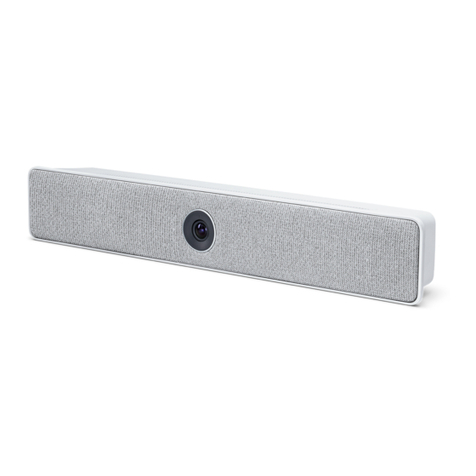
Cisco
Cisco Webex Room Kit Mini installation guide
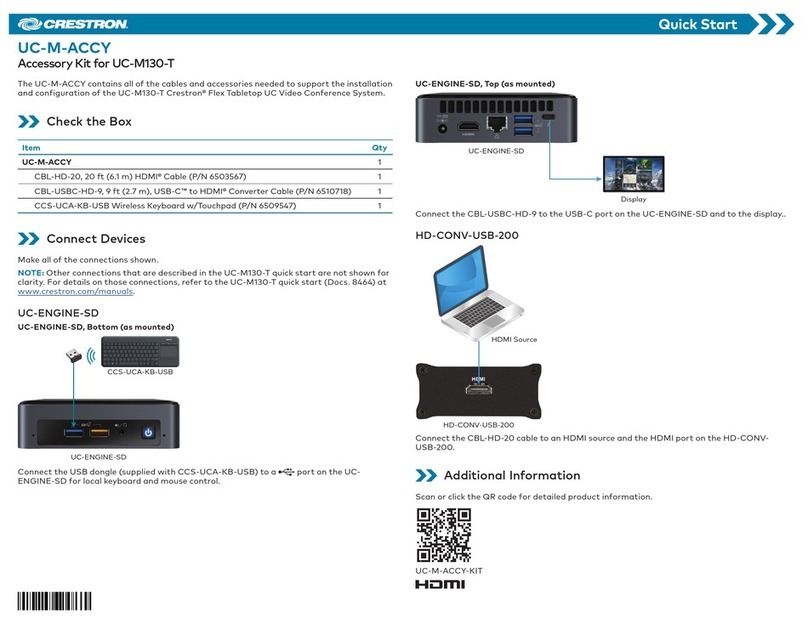
Crestron
Crestron UC-M-ACCY quick start guide

Sony
Sony PCS-1500 operating instructions
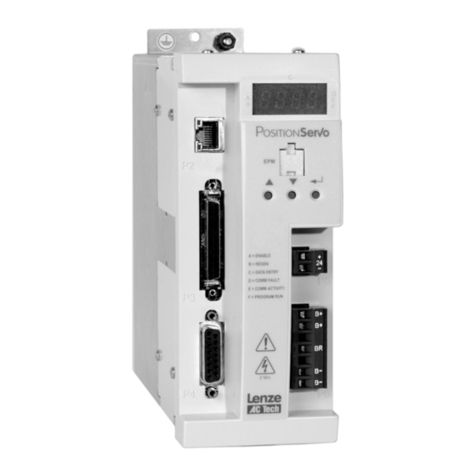
Lenze
Lenze AC Tech MotionView OnBoard PositionServo... reference guide
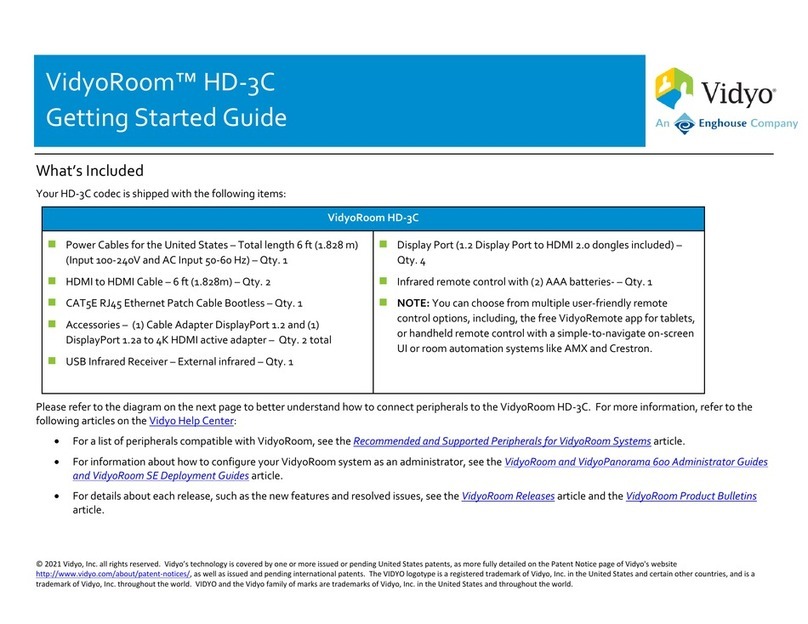
Enghouse
Enghouse VidyoRoom HD-3C Getting started guide
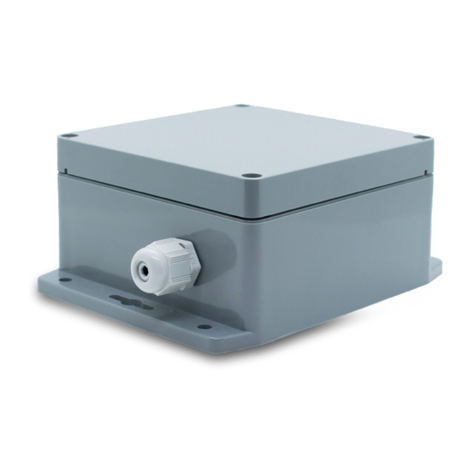
Flexitron
Flexitron webdyn MTX-StarWater Software user's guide
